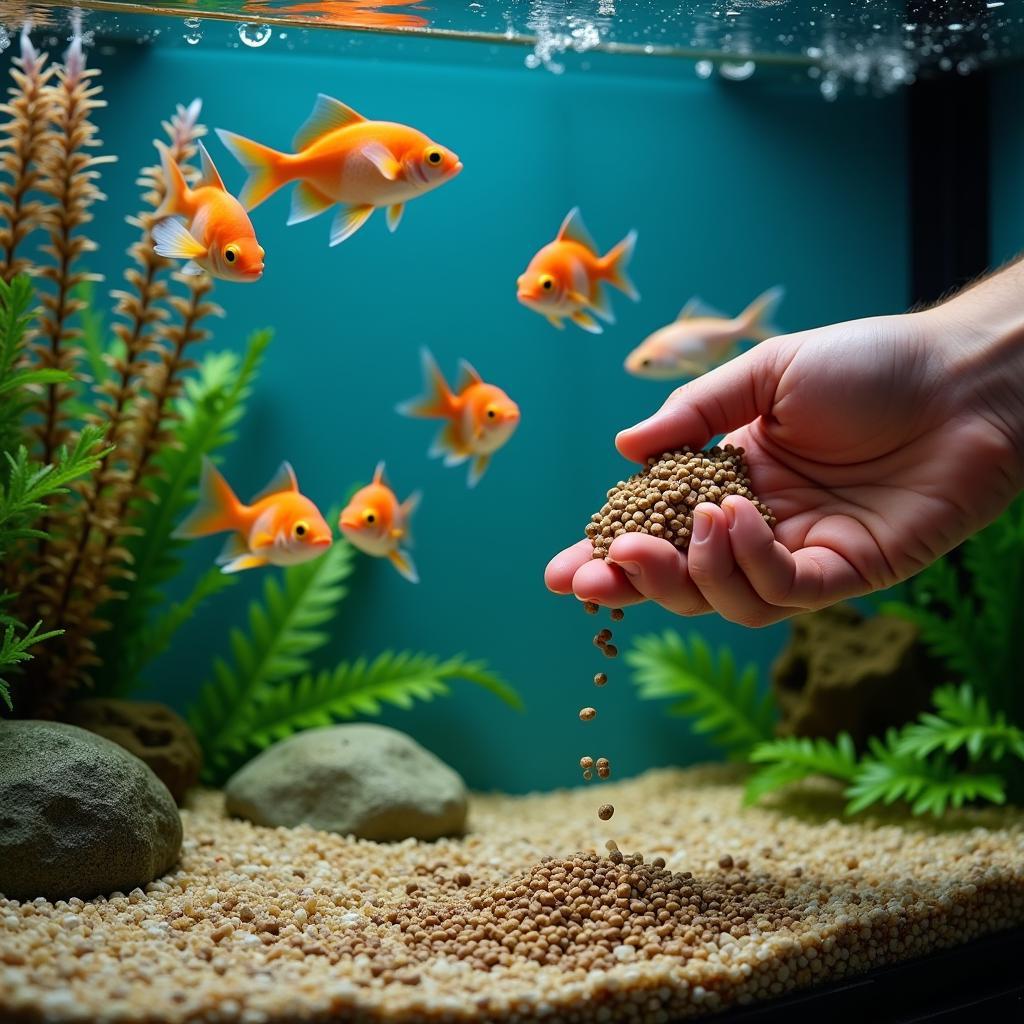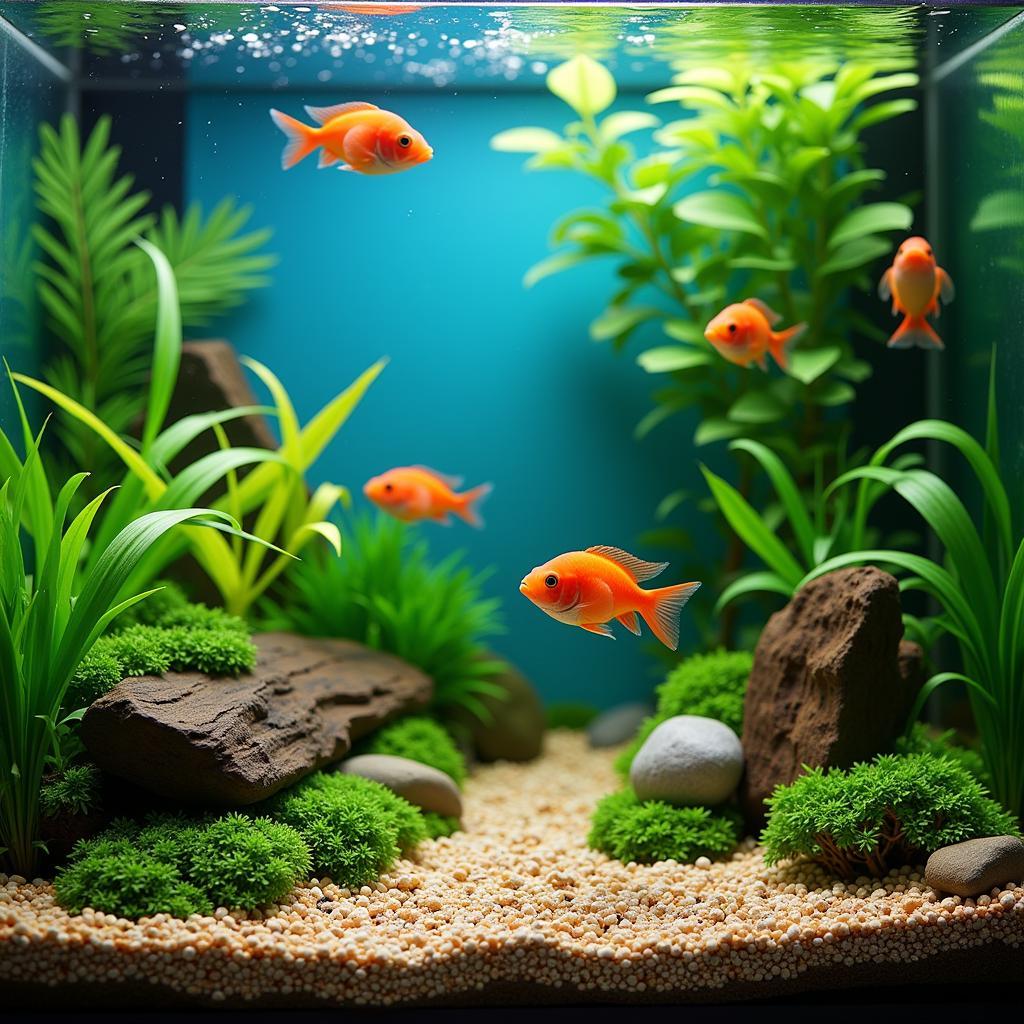Floating Fish Food Pellets are a staple in many aquariums. They offer a convenient, nutritionally balanced diet for a variety of fish species, making feeding time a breeze. But not all floating pellets are created equal. Understanding the nuances of these little powerhouses of nutrition is key to ensuring your aquatic friends thrive. Let’s dive deep into the world of floating fish food pellets. Here at Mina Cones Food, we’re passionate about helping you choose the best food for your finned companions.
Why Choose Floating Fish Food Pellets?
Floating pellets offer several advantages over sinking pellets. Their buoyancy makes it easy to monitor how much your fish are eating, preventing overfeeding and minimizing waste that can contribute to poor water quality. This is especially important for beginners. Floating pellets also allow you to observe your fish’s feeding behavior, giving you insights into their health and appetite. For surface-dwelling fish, floating pellets are a natural and accessible food source. Check out our fish food floating pellets.
Benefits of Floating Pellets
- Reduced Water Pollution: Uneaten sinking pellets can decompose at the bottom of the tank, negatively impacting water quality. Floating pellets minimize this issue.
- Easier Monitoring: See exactly how much your fish are eating and adjust feeding amounts accordingly.
- Ideal for Surface Feeders: Catered to the natural feeding habits of many popular aquarium species.
- Variety of Formulations: Available in various sizes and compositions to suit different fish species and dietary needs.
Selecting the Right Floating Fish Food Pellets
Choosing the right floating fish food pellets depends on several factors, including the species of fish you keep, their age, and their specific dietary requirements.
Considering Your Fish’s Needs
- Species: Different species have different nutritional needs. Research your fish’s specific requirements. Do you have bottom feeders in your tank? If so, you may want to consider supplementing with bottom feeder food.
- Age: Young, growing fish require a higher protein diet than adult fish. Look for pellets specifically formulated for fry or juveniles.
- Dietary Requirements: Some fish, such as goldfish, require a diet lower in protein and higher in carbohydrates. Look for specialized sinking fish food for goldfish if you have these beautiful creatures in your tank.
Ingredients to Look For
High-quality floating fish food pellets should contain a balanced mix of proteins, carbohydrates, fats, vitamins, and minerals. Look for ingredients like fish meal, krill, spirulina, and other nutrient-rich sources. Consider trying fish food with spirulina for added nutritional benefits.
How to Feed Floating Fish Food Pellets
While feeding floating pellets is generally straightforward, there are a few best practices to ensure optimal fish health.
Feeding Guidelines
- Frequency: Most adult fish thrive on one or two feedings per day. Young fish may require more frequent feedings.
- Amount: Feed only what your fish can consume within a few minutes. Overfeeding can lead to water quality issues.
- Observation: Watch your fish during feeding time. Are they eating enthusiastically? Are there any pellets left uneaten? Adjust your feeding routine as needed.
Commonly Asked Questions about Floating Fish Food Pellets
What are the advantages of using floating fish food pellets? Floating pellets reduce water pollution, allow for easy monitoring of food intake, and are ideal for surface feeders.
How often should I feed my fish floating pellets? Most adult fish require one to two feedings a day. Adjust based on your fish’s species and age.
Can I mix floating pellets with other types of fish food? Yes, you can supplement floating pellets with other food types to provide a varied diet, ensuring all your fish’s nutritional needs are met. For instance, fish food for bluegill can be a good addition for specific species.
 Feeding Fish with Floating Pellets
Feeding Fish with Floating Pellets
“The right diet is crucial for healthy, vibrant fish,” says renowned aquarist, Dr. Amelia Reed. “Floating pellets provide a convenient and effective way to deliver essential nutrients while minimizing waste.”
Maintaining Water Quality
While floating pellets help minimize waste, regular water changes and proper filtration are still essential for maintaining a healthy aquarium environment.
“Consistent water quality is paramount to the overall health of your aquarium,” adds Dr. Reed. “Even with floating pellets, regular maintenance is key.”
 Healthy Aquarium Using Floating Pellets
Healthy Aquarium Using Floating Pellets
In conclusion, floating fish food pellets offer a practical and nutritious way to feed a variety of fish species. By carefully selecting the right pellets and following proper feeding guidelines, you can ensure your aquatic friends thrive. Remember to consider your fish’s specific needs when choosing a pellet type. Floating fish food pellets are a cornerstone of a healthy and vibrant aquarium.
For any assistance, please contact us at Phone Number: 02437655121, Email: [email protected] Or visit us at: 3PGH+8R9, ĐT70A, thôn Trung, Bắc Từ Liêm, Hà Nội, Việt Nam. We have a 24/7 customer support team.